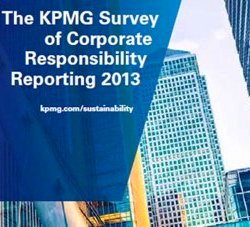 Most large companies acknowledge risks from environmental and social “megaforces” but few link corporate responsibility to remuneration
Most large companies acknowledge risks from environmental and social “megaforces” but few link corporate responsibility to remuneration- Only 5 percent report the potential impact of environmental and social risks on their financial results
- Corporate responsibility reporting is now mainstream global business practice – 71 percent of companies worldwide publish a corporate responsibility report
Three quarters (75 percent) of the world’s 250 largest companies[1] (G250) researched by KPMG acknowledge risks to their business from environmental and social “megaforces”, such as resource scarcity and climate change, in corporate responsibility (CR) reports. Yet only one in ten (10 percent) that reports on CR clearly links CR performance to remuneration[2], suggesting that many companies are failing to incentivise their executives to manage these risks effectively.
The findings from the eighth KPMG Survey of Corporate Responsibility Reporting published on December 9 also reveal that only 5 percent of G250 reporting companies quantify and report the potential impact of environmental and social risks on financial performance.
“Environmental and social risks can impact the supply chain, productivity, financial performance, reputation and brand value. So it is disappointing to see that so many companies still shy away from quantifying these risks in financial terms and few factor in the management of these risks into executive remuneration,” said Yvo de Boer, KPMG’s Global Chairman, Climate Change & Sustainability Services.
“More and more investors accept that environmental and social megaforces put company value at stake. As their understanding grows, they will expect companies to be transparent about the risks they face, what the financial impacts of those risks could be, and what the company is doing to mitigate them. Our research suggests that many companies still have a long way to go on that front.”
According to the KPMG survey results, financial quantification of environmental and social risks is most prevalent in the financial and oil & gas sectors. Eight of the 11 G250 companies, that quantify at least some of their environmental and social risks in financial terms, are in these sectors.
The KPMG Survey of Corporate Responsibility Reporting 2013 also shows that CR reporting is now a mainstream business activity all over the world practiced by 71 percent of the 4100 companies studied across 41 countries. In 1993, when the KPMG survey was first published, the average global CR reporting rate was only 12 percent.
The greatest growth in CR reporting has been in the Asia-Pacific region where the average CR reporting rate has increased from 49 percent two years ago to 71 percent in the 2013 survey.
A Mindset Shift from Risk to Opportunity?
KPMG’s research suggests a shift in mindset from risk to opportunity occurring among many large companies. More G250 companies mentioned the opportunities of environmental and social megaforces in their CR reporting than mentioned risks (87 percent Vs. 81 percent of G250 companies reporting).
Of the opportunities referred to, innovation and learning is the most commonly mentioned – identified in almost three quarters of G250 CR reports (72 percent). Around half (51 percent) of reporting companies mention the opportunity to strengthen their brand and around one third (36 percent) report the opportunity to grow market share.
“Corporate responsibility is no longer simply a moral issue and companies recognise this. They increasingly view it as a critical lens on concrete business risks and opportunities. It is encouraging to see that large companies are now seeing environmental and social change as a source of opportunity as much as, or more than a source of risk, providing a more rounded view for stakeholders,” said de Boer.
CR Reporting Leaders
This year, for the first time, the KPMG Survey of Corporate Responsibility Reporting includes an in-depth assessment of CR reports published by the G250 companies – the world’s 250 largest companies according to Fortune 2012.
KPMG professionals assessed the quality of G250 reports against seven key criteria (strategy, risk and opportunity; materiality; targets and indicators; suppliers and the value chain; stakeholder engagement; governance; transparency and balance). Each company’s reporting was awarded an overall quality score. For the 93 percent of G250 companies that publish a CR report, the average quality score was 59 out of 100.
The electronics and computer sector emerged as the leader for quality of reporting, scoring an average 75 out of 100, closely followed by the mining and pharmaceutical sectors, each achieving an average of 70. At the other end of the scale, sectors which trailed with the lowest scores were construction and building materials at 46 and metals, engineering & manufacturing at 48.
The survey was also used to identify a cluster of 10 companies that stood out for the quality of their CR reporting. They were: A.P. Møller Mærsk (Transport – Denmark), BMW (Automotive – Germany), Cisco Systems (Communications & media – USA), Ford Motor Company (Automotive – USA), Hewlett-Packard (Electronics & computers – USA), ING (Finance, insurance, & securities – Netherlands), Nestlé (Food & beverage – Switzerland), Repsol (Oil & gas – Spain), Siemens (Electronics & computers – Germany), and Total (Oil & gas – France).














